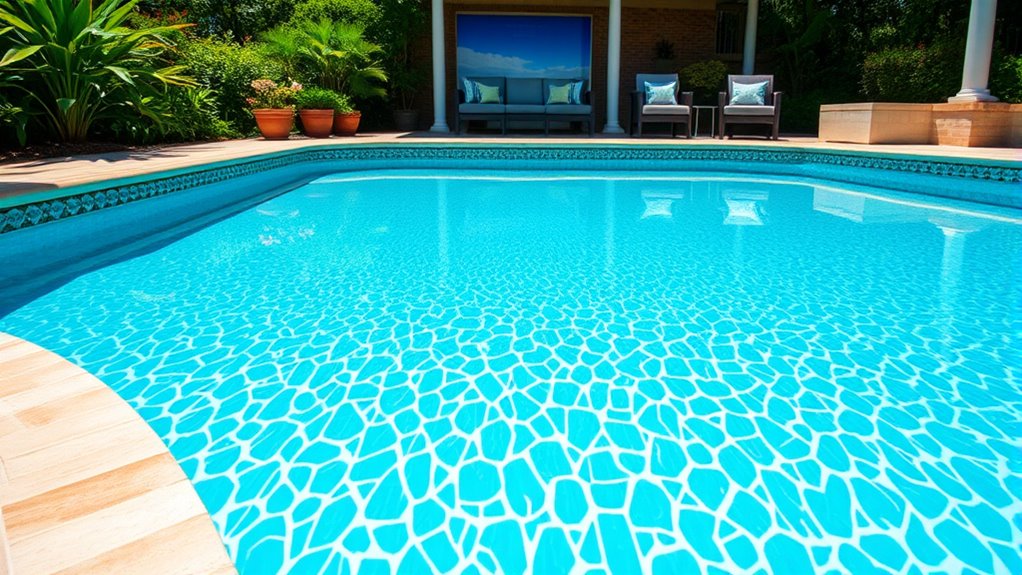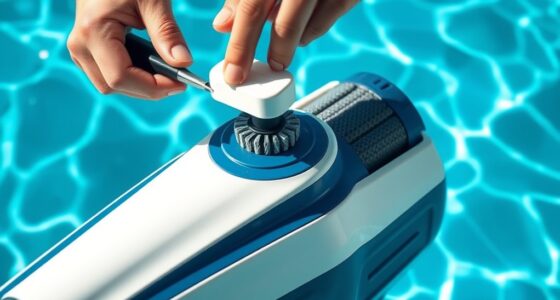To give your old pool a fresh look, re-tiling and resurfacing are great options when you notice cracks, fading, or slipperiness. Re-tiling involves removing damaged tiles and installing new, durable ones, while resurfacing applies a new coating to improve appearance and protect your pool’s structure. Both choices enhance safety and extend your pool’s lifespan. Keep exploring to discover detailed steps and tips for a successful upgrade.
Key Takeaways
- Re-tiling and resurfacing restore your pool’s appearance, making it look new and modern.
- These upgrades protect the pool structure from leaks, cracks, and further damage.
- Proper surface preparation and water chemistry management are essential for long-lasting results.
- Options include durable tiles or coatings like plaster, pebble, or quartz finishes for various styles.
- Regular maintenance post-project preserves the new surface’s beauty and safety.

Are your tiles looking worn-out or outdated? If so, it’s probably time to think about re-tiling or resurfacing your pool to give it a fresh, inviting look. Over time, exposure to sun, water, and chemicals can cause tiles to fade, crack, or become slippery, detracting from your pool’s appearance and safety. While a thorough clean might help temporarily, the real transformation comes with re-tiling or resurfacing. These upgrades not only improve aesthetics but also protect your pool’s structure, preventing leaks and further deterioration.
Worn-out tiles? Re-tiling or resurfacing rejuvenates your pool’s look and protects its structure.
Before diving into the process, it’s essential to understand the importance of proper pool maintenance and water chemistry. Maintaining balanced water chemistry is vital during and after re-tiling or resurfacing. Proper water chemistry ensures the new surface stays in top condition, prevents algae growth, and keeps your pool safe for swimmers. During the project, you’ll need to temporarily adjust your water pH and sanitizer levels, especially if you’re removing old tiles or applying new coatings. Once complete, maintaining consistent water chemistry will extend the life of your new surface and keep your pool looking pristine.
Re-tiling involves removing the old, damaged tiles and replacing them with new ones. While it sounds straightforward, it requires careful planning and precise execution to ensure a uniform finish. You’ll want to choose tiles that complement your backyard decor and are suitable for water exposure. Glass, ceramic, or stone tiles are popular choices, each offering durability and style. The process includes cleaning the surface thoroughly, removing old tiles, repairing any underlying damage, and then applying new adhesive and grout. It’s a meticulous process, but the result can make your pool look like new, with a clean, modern aesthetic. Additionally, selecting high-quality tiles with high color accuracy ensures a vibrant and long-lasting appearance.
Resurfacing, on the other hand, involves applying a new coating over the existing surface. This option is often more cost-effective and quicker than re-tiling. Resurfacing can be done with materials like plaster, pebble, or quartz finishes, giving your pool a smooth, attractive surface that resists staining and algae buildup. The surface is prepared carefully, with any cracks or imperfections filled, then cleaned and primed before the new coating is applied. Once finished, you’ll need to circulate and balance your water chemistry properly to cure the surface and ensure it stays in excellent condition for years to come.
In either case, think about hiring professionals to handle the job. They’ll ensure proper surface preparation, precise application, and safe handling of materials. With the right approach, re-tiling or resurfacing will transform your old pool into a stunning centerpiece that invites you to relax and enjoy every swim. Just remember, ongoing pool maintenance and water chemistry management are key to preserving your investment and keeping your pool looking its best for years ahead.
Frequently Asked Questions
How Long Does Re-Tiling Typically Take?
When you ask how long re-tiling typically takes, timing considerations come into play. The project duration depends on factors like pool size, tile type, and surface condition. Usually, it takes about 1 to 2 weeks, but complex projects may take longer. You should plan for some downtime, as the process involves draining, surface prep, tile installation, and curing. Proper scheduling guarantees a smooth, efficient transformation of your pool.
What Are the Best Materials for Pool Resurfacing?
Choosing the best materials for pool resurfacing is like selecting the perfect outfit—your pool’s look and longevity depend on it. You’ll want options with vibrant pool color options and tile durability that withstands harsh chemicals and weather. Pebble finishes, quartz, and plaster are popular choices, each offering durability and aesthetic appeal. Consider your desired style and maintenance needs to pick a material that keeps your pool beautiful and functional for years.
Can I Customize the Tile Design?
Yes, you can definitely customize your pool tile design. With a variety of pool design options available, you have the freedom to choose from different colors, patterns, and textures. Tile customization ideas include mosaics, geometric patterns, or even personalized images. This allows you to create a unique, stylish look that reflects your personality and complements your backyard, making your pool truly one-of-a-kind.
How Much Does Re-Tiling and Resurfacing Cost?
Imagine your pool as a canvas; re-tiling and resurfacing refresh its look. Costs vary widely, like choosing between a boutique and a big-box store. On average, expect $4,000 to $10,000, but this depends on size and materials. To get the best value, compare contractor quotes carefully, focusing on experience and reputation. A good contractor is worth the extra investment for a long-lasting, stunning finish.
Is There Any Maintenance Required After Re-Tiling?
After re-tiling, you’ll need to keep up with regular pool cleaning to prevent debris buildup and algae growth. It’s also essential to check and maintain the chemical balance frequently, ensuring your pool stays safe and clear. Inspect the tiles periodically for any signs of damage or loose grout, and address issues promptly. Staying on top of these maintenance tasks will help your newly tiled pool stay beautiful and functional for years.
Conclusion
By re-tiling and resurfacing, you can transform your old pool into a stunning centerpiece. Imagine upgrading a tired, chipped surface to a sleek, modern finish—like the homeowner who revitalized their backyard with vibrant tiles and a fresh coat of resurfacing material. Not only does it boost your pool’s appearance, but it also extends its lifespan. So, don’t wait—give your pool a fresh look and enjoy your backyard oasis once again.









